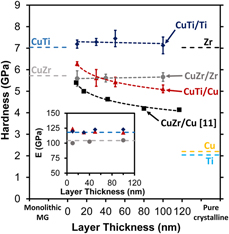Article contents
Size-independent strength of amorphous–HCP crystalline metallic nanolayers
Published online by Cambridge University Press: 12 March 2019
Abstract

Amorphous/crystalline (A/C) nanolayers provide an effective model system to study the mechanical behavior and size effects of metallic glasses and crystalline metals in confined geometries. In this work, we experimentally investigated the structure–property relationship in A/C nanolayers containing HCP crystalline layers. CuTi/Ti and CuZr/Zr nanolayers were prepared by magnetron sputtering with layer thicknesses in the range 10–100 nm. The hardness values of the CuTi/Ti and CuZr/Zr nanolayers were close to those of the monolithic CuTi and CuZr, respectively. The hardness remained virtually the same for different layer thicknesses as opposed to CuTi/Cu amorphous/FCC crystalline nanolayers, which exhibit increasing strength with decreasing layer thickness. Confined layer slip model predicts that the effective flow stress of HCP crystalline layers is higher than that of the amorphous layers. As a result, the strength and size effects are governed by the mechanical behavior of the softer amorphous layer.
- Type
- Article
- Information
- Journal of Materials Research , Volume 34 , Issue 13: Focus Issue: Intrinsic and Extrinsic Size Effects in Materials , 15 July 2019 , pp. 2275 - 2284
- Copyright
- Copyright © Materials Research Society 2019
References
- 10
- Cited by




